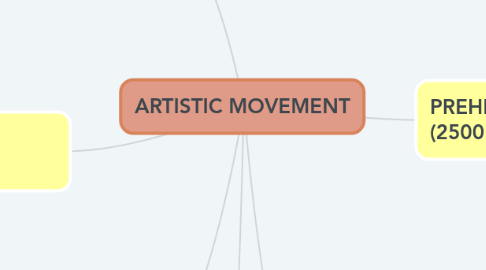
1. CUBISM (1907- 1912)
1.1. The color schemes that is visible to the Cubism Art is a monochromatic to avoid the distraction in the primary interest of the art. Cubism is more focused on the presentation of a coals. This art movement also shows different perspectives to identify the totality of objects in the same plane.
1.1.1. In 1907, the first cubist painting was shown by Picasso to Braque. A French critic, Louis Vauxcelles first used the term Cubism in the 1908 to describe the landscape painting made by Braque.
1.1.1.1. Major Cubism Artist : Pablo Picasso Georges Braque Paul Czanne Juan Gris Fernand Lger Piet Mondrian
2. FUTURISM (1909 - 1914)
2.1. Futurism tends to show the people the things which are hidden in the real world. The idea of aggression, which becomes the aesthetic doctrine of Italian fascism. The evolution of the modernist concept, the expression of the essence of the object.
2.1.1. With the publication of the Futurist Manifesto, Futurism began its transformation of the Italian culture. This is considered to be a Italian Movement because this began in Milan, Italy.
2.1.1.1. Major Futurism Artist : Marcel Janco Gino Severini David Bomberg Alexander Bogomazov Joseph Stella Giacomo Balla Vsevolod Meyerhold Luigi Russolo Umberto Boccioni Carlo Carrà
3. EXPRESSIONISM (1905 - 1920)
3.1. This art movement is where the artist expressed their feelings and emotions. The use of colors are intense to show the unreal and does not directly represent reality. Lines are thick and angular. Subjective aspects are the focuses on this artwork.
3.1.1. To describe the painting, where it shows a strong emotion by the artist, the expressionism word was used. This was first used in the year 1850. In 1910, the Expressionism increased because Antonin Matějček coined the term.
3.1.1.1. Major Expressionism Artist : Edvard Munch Vincent van Gogh Egon Schiele Wassily Kandinsky Paul Klee Donray Oskar Kokoschka Camilo Mori
4. SURREALISM (1924 -1968)
4.1. Emphasize the mythological , marvelous and mysterious feelings. This is a form of art which is ambiguous. This also allows the flow to freely move and also a unconscious creation.
4.1.1. With Andre Breton's Surrealist Manifesto in the year 1924, Surrealism Movement had began. The movement was influenced by Sigmund Freud.
4.1.1.1. Major Surrealism Artist : SALVADOR DALÍ RENÉ MAGRITTE ANDRÉ BRETON JOAN MIRÓ MAX ERNST
5. PREHISTORIC (2500 B.C.E)
5.1. Prehistoric Art dominates images of animals which has black outlines and realistically represented. The features would be found in the materials utilized, which could include charcoal, ash, pigment, or stone or wood sculptures.
5.1.1. Artifacts created before there was a written record are referred to as prehistoric art. People had mastered the art of designing forms that were both functional and beautiful long before the earliest recorded languages were formed. The earliest art dates from the Paleolithic (Old Stone Age), but the Neolithic (New Stone Age) is when we see the most significant changes in human history.
5.1.1.1. There are no know famous artist during the prehistoric art because during this period human are all artist. They do things in every way it is possible.
6. ANCIENT ART (30000 B.C.E - 400 A.D)
6.1. High aesthetic idealism is an idyllic and perfect picture of the artistic mind that is perceived and expressed by them in their many artwork platforms, rather than a natural and direct reality portrayal.
6.1.1. Dadaism Movement started in Europe at the year 1916 and was evident during the World War I. There were 3 art movements that influenced Dadaism namely, Futurism, Expressionism and Cubism.
6.1.1.1. Major Dadaism Artist : Salvador Dali Marcel Janco Marcel Duchamp Hans Bellmer Joan Miró Man Ray Francis Picabia Max Ernst Benjamin Péret Alice Bailly
